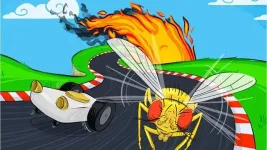Aquatic invasive species cause damage worth billions of dollars
First global study on economic costs of aquatic invasive species published
2021-04-06
(Press-News.org) The global movement of goods and people, in its modern form, has many unwanted side effects. One of these is that animal and plant species travel around the world with it. Often they fail to establish themselves in the ecosystems of the destination areas. Sometimes, however, due to a lack of effective management, they multiply to such an extent in the new environment that they become a threat to the entire ecosystem and economy. Thousands of alien species are currently documented worldwide. A quarter of them are in highly vulnerable, aquatic habitats.
So far, research has mainly focused on the ecological consequences of these invasions. In a first global data analysis, 20 scientists from 13 countries led by GEOMAR Helmholtz Centre for Ocean Research Kiel have now compiled the economic costs caused specifically by aquatic invaders. "We come to the conclusion that invasive aquatic species that have established themselves in their new habitats have cost at least 345 billion US dollars since the 1970s," says Dr Ross Cuthbert from GEOMAR. He is lead author of the study, which has now been published in the journal Science of the Total Environment.
Economic costs occur, for example, when invasive species decimate commercially exploited fish stocks, spread deadly diseases or damage infrastructures. "Good examples include invasive mussels that clog intake pipes of factories, power plants or water treatment plants. Or, alien parasites that cause catastrophic declines in commercial fisheries," explains Dr Cuthbert.
For the study, the team used cases recorded in the existing literature and standardized them in a comprehensive database. Invertebrates (62%) accounted for the largest proportion of costs that could be detected in this way, followed by vertebrates (28%) and plants (6%). The largest costs were reported in North America (48 %) and Asia (13 %) and were mainly due to damages to resources such as physical infrastructures, healthcare systems and fisheries. Worryingly, over ten-times less was spent on management actions, such as prevention of future invasions, than damages.
"However, our figures are vastly underestimated due to knowledge gaps. Costs were never reported for many countries and known damaging invasive species, especially in Africa and Asia. So, we can assume that the damages are actually much higher," Dr Cuthbert points out. A comparison with the costs caused by invaders on land confirms this assumption. While aquatic species make up a quarter of the documented invasive species, the economic costs they cause comprise only a twentieth of what is known for terrestrial species.
The team also identified a clear trend that costs have increased significantly in recent years. In 2020 alone, they amounted to at least 23 billion US dollars.
"So, the costs of aquatic invaders are significant, but probably under-reported. Costs have increased over time and are expected to continue to increase with future invasions," Dr Cuthbert summarises the study. The team of authors therefore calls for increased and improved cost reporting by managers, practitioners and researchers to reduce knowledge gaps. It also urges more money to be invested in invasion management and prevention. "This would be money well spent to prevent and limit current and future damage," Dr Cuthbert emphasises.
INFORMATION:
[Attachments] See images for this press release:

ELSE PRESS RELEASES FROM THIS DATE:
2021-04-06
Researchers from Columbia University and Georgetown University published a new paper in the Journal of Marketing that examines how consumers can adopt a sustainable consumption lifestyle by purchasing durable high-end and luxury products.
The study, forthcoming in the Journal of Marketing, is titled "Buy Less, Buy Luxury: Understanding and Overcoming Product Durability Neglect for Sustainable Consumption" and is authored by Jennifer Sun, Silvia Bellezza, and Neeru Paharia.
What do luxury products and sustainable goods have in common? Luxury goods possess a unique, sustainable trait that gives them a longer lifespan than lower-end products.
Sustainable consumption is on the rise with all consumers. However, younger millennial ...
2021-04-06
BOSTON - A gene called KRAS is one of the most commonly mutated genes in all human cancers, and targeted drugs that inhibit the protein expressed by mutated KRAS have shown promising results in clinical trials, with potential approvals by the U.S. Food and Drug Administration anticipated later this year. Unfortunately, cancer cells often develop additional mutations that make them resistant to such targeted drugs, resulting in disease relapse. Now researchers led by a team at Massachusetts General Hospital (MGH) have identified the first resistance mechanisms that may occur to these drugs and identified strategies to overcome them. The findings are published in END ...
2021-04-06
With over 70% of respondents to a AAA annual survey on autonomous driving reporting they would fear being in a fully self-driving car, makers like Tesla may be back to the drawing board before rolling out fully autonomous self-driving systems. But new research from Northwestern University shows us we may be better off putting fruit flies behind the wheel instead of robots.
Drosophila have been subjects of science as long as humans have been running experiments in labs. But given their size, it's easy to wonder what can be learned by observing them. Research published today in the journal Nature Communications demonstrates that fruit flies use decision-making, learning and memory to perform simple functions like escaping heat. And researchers are using ...
2021-04-06
LAWRENCE -- An international trade law expert at the University of Kansas argues in a pair of new articles that human rights and trade are now inextricably linked, as evidenced by U.S. and international reactions to actions in China, and asserts that approach is an appropriate use of trade.
Raj BhalaAfter the United States, then Canada and the Netherlands, declared the Chinese Communist Party's actions against Uyghur Muslims as genocide, the nations followed with various trade sanctions. Likewise, countries have adopted trade measures in response to China's violation of its one-country, two-systems agreement with Hong Kong. ...
2021-04-06
Researchers at the University of Konstanz and Max Planck Institute for Animal Behavior in Germany have found that birds are able to change their culture to become more efficient. Populations of great tits were able to switch from one behavior to a better alternative when their group members were slowly replaced with new birds. Published today as open access in the journal Current Biology, this research reveals immigration as a powerful driver of cultural change in animal groups that could help them to adapt to rapidly changing environments.
In animals, "culture" is considered to be any behavior that is learned from others, shared by members of the ...
2021-04-06
Ann Arbor, April 6, 2021 - New data from the Centers for Disease Control and Prevention (CDC) show that one in four adults with HIV in the United States has experienced intimate partner violence (IPV), which disproportionately affects women and LGBT populations. Further, people with HIV who experienced IPV in the past 12 months were more likely to engage in behaviors associated with elevated HIV transmission risk, were less likely to be engaged in routine HIV care and more likely to seek emergency care services and have poor HIV clinical outcomes. The findings are reported in the American Journal of Preventive Medicine, published by Elsevier.
Lead Investigator Ansley B. Lemons-Lyn, MPH, and colleagues from the CDC's National Center for HIV/AIDS, Viral Hepatitis, ...
2021-04-06
At a cost of $38 billion a year, an estimated 5.3 million people are living with a permanent disability related to traumatic brain injury in the United States today, according to the Centers for Disease Control and Prevention. The physical, mental and financial toll of a TBI can be enormous, but new research from the University of Georgia provides promise.
In a new study, researchers at UGA's Regenerative Biosciences Center have demonstrated the long-term benefits of a hydrogel, which they call "brain glue," for the treatment of traumatic brain injury. The new study provides evidence that not only does the gel protect against loss of brain tissue after ...
2021-04-06
Bethesda, MD (April 6, 2021) -- Obesity is a global pandemic, affecting about 40% of adults in the United States. There is an enormous unmet need for an effective weight-loss solution. After a detailed review of available literature, the American Gastroenterological Association (AGA) has released new clinical guidelines recommending the use of intragastric balloons (IGB) for patients with obesity who have not been able to lose weight with traditional weight-loss strategies. This treatment is most successful with accompanying therapy, such as lifestyle modifications and pharmacological agents, ...
2021-04-06
Researchers have uncovered pathways involved in the body's response to glucocorticoid treatments and identified a novel biomarker that could be used to monitor how these drugs work in patients, according to a clinical study published today in eLife.
A more reliable indicator of an individual's response to glucocorticoid drugs could be used to develop a clinically applicable test that could help tailor treatments and potentially minimise side-effects.
Glucocorticoids, such as cortisol, are a type of hormone with key roles in the body's response to stress. Glucocorticoid ...
2021-04-06
Researchers from Skoltech and their collaborators have designed, synthesized and evaluated new compounds that can serve as catholytes and anolytes for organic redox flow batteries, bringing this promising technology closer to large-scale implementation. The two papers were published in the END ...
LAST 30 PRESS RELEASES:
[Press-News.org] Aquatic invasive species cause damage worth billions of dollars
First global study on economic costs of aquatic invasive species published


